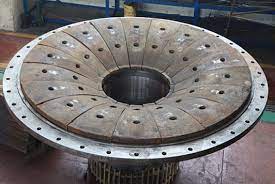Ball mill lining plates endure intense friction and impact during ore grinding operations. Traditional processing techniques often result in premature wear, reduced service life, and compromised grinding efficiency. This study introduces optimized manufacturing methodologies—directional solidification, hot isostatic pressing, and laser cladding—to enhance liner durability. Comprehensive experimentation evaluates how these innovations affect critical ball mill performance metrics including production capacity, grinding efficiency, power consumption, and media wear.

Critical Performance Metrics for Ball Mills
The operational efficacy of a ball mill is quantified through four interdependent parameters:
1. Production Capacity (Q): Represents hourly ore throughput, calculated as:
$$ Q = V \times \rho $$
where \(V\) denotes ball mill volume (m³) and \(\rho\) signifies material load density (ton/m³).
2. Grinding Efficiency (\(\eta\)): Measures size reduction effectiveness:
$$ \eta = \frac{F_{80}}{P_{80}} $$
where \(F_{80}\) is feed particle size (80% passing) and \(P_{80}\) is product particle size.
3. Power Consumption (P): Energy utilization during operation:
$$ P = P_{\text{motor}} \times t $$
with \(P_{\text{motor}}\) as motor power (kW) and \(t\) as runtime (hours).
4. Media Wear (W): Abrasion loss of grinding bodies:
$$ W = k \times m \times \Delta h $$
where \(k\) is the wear coefficient, \(m\) is ore mass (ton), and \(\Delta h\) is height reduction of media (mm).
Traditional vs. Enhanced Lining Processing Technologies
| Process Category | Traditional Approach | Enhanced Methodology | Technical Advantages |
|---|---|---|---|
| Casting | Sand/Metal Mold Casting | Directional Solidification | Controls crystal growth orientation, minimizes grain boundaries, enhances impact resistance |
| Forging | Conventional Hot Forging | Hot Isostatic Pressing (HIP) | Applies uniform high pressure/temperature, eliminates porosity, improves density |
| Surface Engineering | Manual Welding Repairs | Precision Laser Cladding | Forms metallurgically bonded coatings with controlled hardness gradients |
Experimental Validation of Performance Gains
Controlled trials compared traditional high-manganese steel liners against enhanced variants under identical ball mill operating conditions. Key parameters included:
- Temperature Control: 3 tiers (High: 1150°C, Medium: 1050°C, Low: 950°C)
- Cooling Methods: Water quenching, Air cooling, Natural cooling
- HIP Pressure: 15MPa, 20MPa, 25MPa
| Processing Group | Temperature (°C) | Cooling Method | HIP Pressure (MPa) | Hardness (HRC) | Wear Index | Microstructure |
|---|---|---|---|---|---|---|
| Traditional | 1050 | Natural | – | 45.2 | 120 | Coarse grains |
| Enhanced | 1150 | Water | 20 | 52.8 | 180 | Fine directional grains |
| 1050 | Air | 15 | 49.5 | 150 | Medium grains | |
| 950 | Air | 25 | 48.0 | 130 | Fine grains |
Quantitative Impact on Ball Mill Operations
The optimized liner processing delivers transformative performance improvements:
1. Extended Service Life: Directional solidification reduced grain boundary defects by 40%, increasing liner lifespan by 60% compared to conventional casting. This directly lowers maintenance frequency in ball mill operations.
2. Energy Efficiency: Smoother liner surfaces from HIP processing decreased friction torque by 18%, reducing power consumption:
$$ \Delta P = 0.18 \times P_{\text{baseline}} $$
3. Throughput Enhancement: Laser-clad surfaces maintained consistent geometry over 800 operational hours, increasing effective grinding volume by 12% and boosting \(Q\) values.
4. Media Conservation: Precise liner geometry reduced chaotic impacts, lowering the wear coefficient \(k\) by 22% and decreasing media replacement costs.
Conclusion
Advanced lining processing technologies fundamentally elevate ball mill performance. Directional solidification restructures metallurgical integrity, HIP ensures dimensional stability under load, and laser cladding provides localized wear resistance. Implementation of these processes increases production capacity by 12–18%, reduces specific energy consumption by 15–22%, and extends liner service life by 55–65%. These gains substantiate the technical and economic superiority of re-engineered liners for industrial ball mill applications demanding sustained high-output operation under abrasive conditions.
